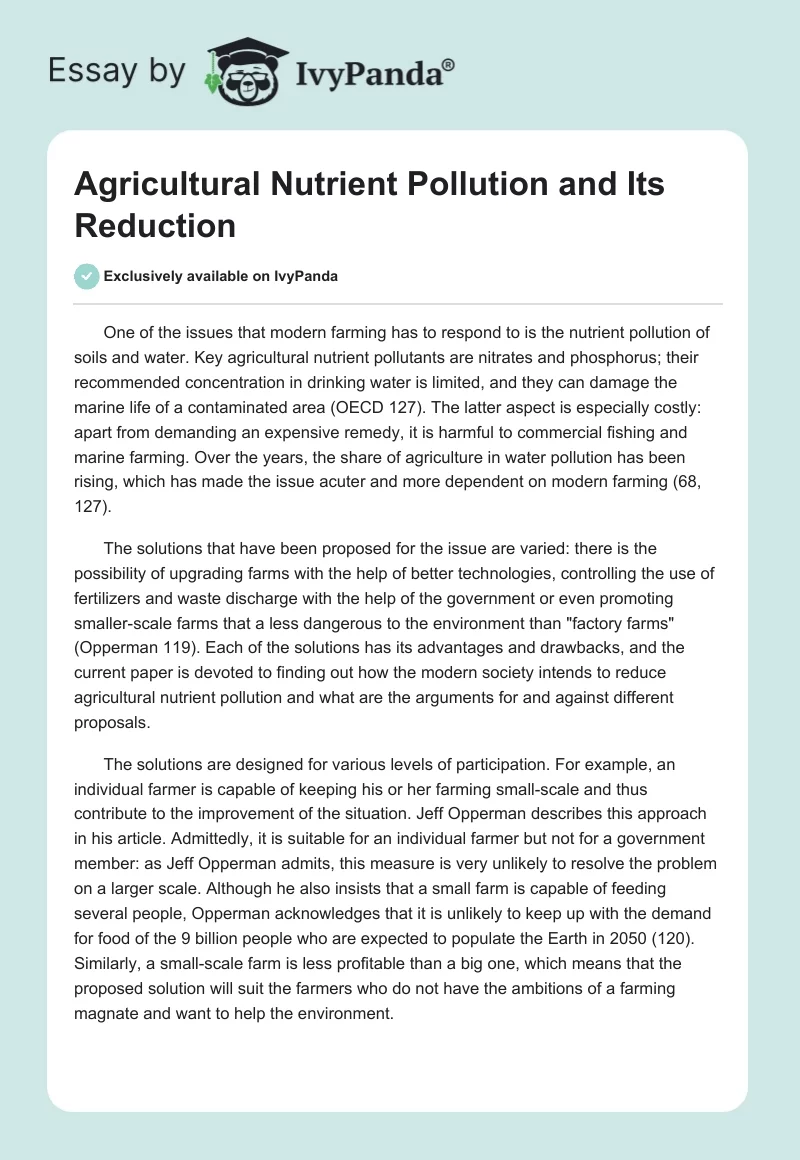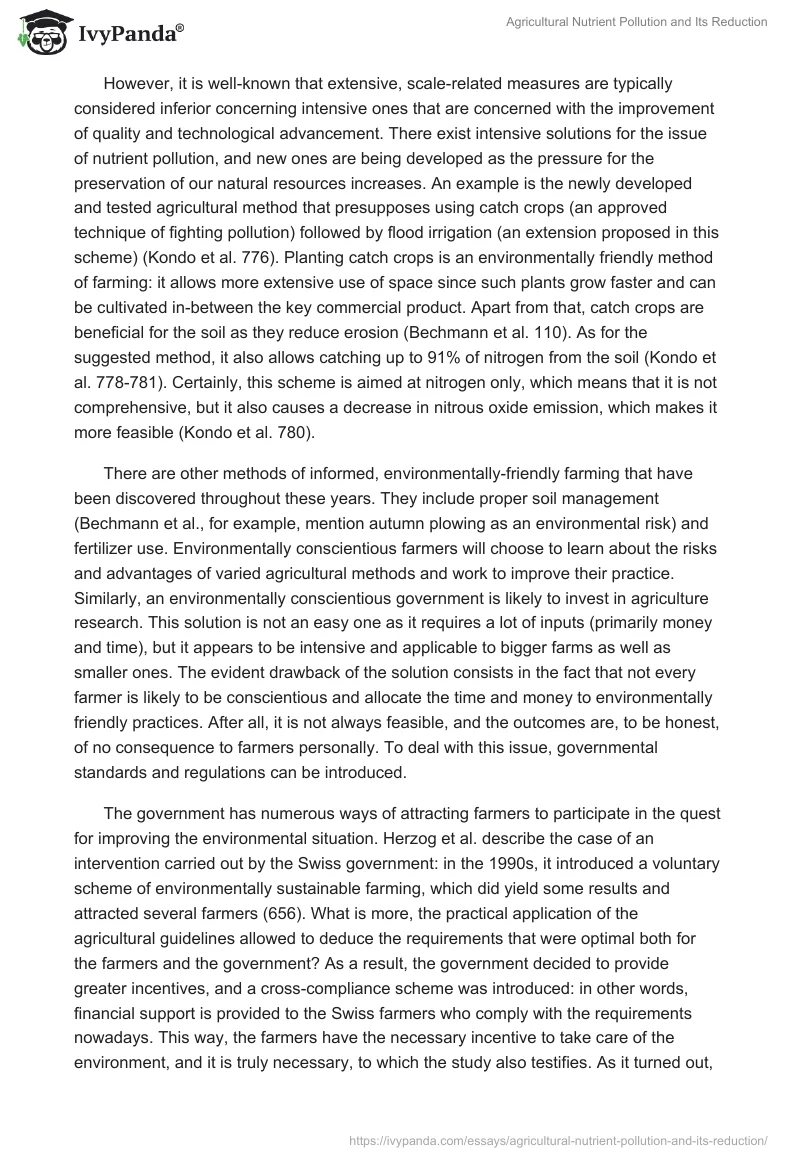One of the issues that modern farming has to respond to is the nutrient pollution of soils and water. Key agricultural nutrient pollutants are nitrates and phosphorus; their recommended concentration in drinking water is limited, and they can damage the marine life of a contaminated area (OECD 127). The latter aspect is especially costly: apart from demanding an expensive remedy, it is harmful to commercial fishing and marine farming. Over the years, the share of agriculture in water pollution has been rising, which has made the issue acuter and more dependent on modern farming (68, 127).
The solutions that have been proposed for the issue are varied: there is the possibility of upgrading farms with the help of better technologies, controlling the use of fertilizers and waste discharge with the help of the government or even promoting smaller-scale farms that a less dangerous to the environment than “factory farms” (Opperman 119). Each of the solutions has its advantages and drawbacks, and the current paper is devoted to finding out how the modern society intends to reduce agricultural nutrient pollution and what are the arguments for and against different proposals.
The solutions are designed for various levels of participation. For example, an individual farmer is capable of keeping his or her farming small-scale and thus contribute to the improvement of the situation. Jeff Opperman describes this approach in his article. Admittedly, it is suitable for an individual farmer but not for a government member: as Jeff Opperman admits, this measure is very unlikely to resolve the problem on a larger scale. Although he also insists that a small farm is capable of feeding several people, Opperman acknowledges that it is unlikely to keep up with the demand for food of the 9 billion people who are expected to populate the Earth in 2050 (120). Similarly, a small-scale farm is less profitable than a big one, which means that the proposed solution will suit the farmers who do not have the ambitions of a farming magnate and want to help the environment.
However, it is well-known that extensive, scale-related measures are typically considered inferior concerning intensive ones that are concerned with the improvement of quality and technological advancement. There exist intensive solutions for the issue of nutrient pollution, and new ones are being developed as the pressure for the preservation of our natural resources increases. An example is the newly developed and tested agricultural method that presupposes using catch crops (an approved technique of fighting pollution) followed by flood irrigation (an extension proposed in this scheme) (Kondo et al. 776). Planting catch crops is an environmentally friendly method of farming: it allows more extensive use of space since such plants grow faster and can be cultivated in-between the key commercial product. Apart from that, catch crops are beneficial for the soil as they reduce erosion (Bechmann et al. 110). As for the suggested method, it also allows catching up to 91% of nitrogen from the soil (Kondo et al. 778-781). Certainly, this scheme is aimed at nitrogen only, which means that it is not comprehensive, but it also causes a decrease in nitrous oxide emission, which makes it more feasible (Kondo et al. 780).
There are other methods of informed, environmentally-friendly farming that have been discovered throughout these years. They include proper soil management (Bechmann et al., for example, mention autumn plowing as an environmental risk) and fertilizer use. Environmentally conscientious farmers will choose to learn about the risks and advantages of varied agricultural methods and work to improve their practice. Similarly, an environmentally conscientious government is likely to invest in agriculture research. This solution is not an easy one as it requires a lot of inputs (primarily money and time), but it appears to be intensive and applicable to bigger farms as well as smaller ones. The evident drawback of the solution consists in the fact that not every farmer is likely to be conscientious and allocate the time and money to environmentally friendly practices. After all, it is not always feasible, and the outcomes are, to be honest, of no consequence to farmers personally. To deal with this issue, governmental standards and regulations can be introduced.
The government has numerous ways of attracting farmers to participate in the quest for improving the environmental situation. Herzog et al. describe the case of an intervention carried out by the Swiss government: in the 1990s, it introduced a voluntary scheme of environmentally sustainable farming, which did yield some results and attracted several farmers (656). What is more, the practical application of the agricultural guidelines allowed to deduce the requirements that were optimal both for the farmers and the government? As a result, the government decided to provide greater incentives, and a cross-compliance scheme was introduced: in other words, financial support is provided to the Swiss farmers who comply with the requirements nowadays. This way, the farmers have the necessary incentive to take care of the environment, and it is truly necessary, to which the study also testifies. As it turned out, the farmers who are not eligible for the support (for example, because of the income or the age of the farmer) are likely to avoid adopting environmentally-friendly farming methods (Herzog et al. 656).
The campaign that is described by Bechmann et al. and that is being carried out in Norway is similar but more comprehensive. Apart from the direct payment, it includes the economic incentive of subsidies, legislative and regulatory interventions, “targeted information campaigns and individual support through extension services” (Bechmann et al. 102). Apart from that, it follows from the article that research in the field of agriculture and Norway farming was promoted, and the resulting tools (for example, soil erosion maps) were recommended for use.
This example demonstrates that the government has the opportunity to carry out a comprehensive solution that is capable of attracting a large number of contributors and providing them with the necessary knowledge and tools. However, this solution also has its limitations and drawbacks. As shown by Herzog et al., the governmental efforts are not always successful: the Swiss government has failed to achieve its goal, particularly concerning nitrogen emissions (665). What is more, as fairly pointed by Herzog et al., governmental spending on environmental campaigns like this one is always impressive but rarely assessed (656). This fact is noteworthy, but it is hardly an argument against this approach; rather, it indicates a direction for its improvement. Herzog et al. compare such governmental campaigns to major experiments (656). It is only logical to assess the results of such experiments to define problematic areas and successful practices.
It can be concluded that there are three levels of contributing to the solution of agricultural nutritional pollution. First of all, individual farmers can improve the situation by keeping to lower-scale farming and introducing advanced techniques and methods. Secondly, governments have several means of convincing farmers to participate and, what is most important, of helping those who are willing to alleviate pollution. Thirdly, the efforts of a single country maybe not sufficient to deal with the global issue, which is why the cooperation of governments is needed for the best of results. An example of such collaboration is the agreement of the countries that have access to the North Sea to protect it (Bechmann et al. 102).
The cooperation on an even larger scale has a greater potential. It is similarly apparent that not every country has an equal opportunity to contribute due to the different levels of economic development. Apart from that, it is not unlikely that not every country is willing to cooperate. However, the lack of cooperation should not dissuade us from contributing to the protection of the environment. The same can be said about the inputs that the solutions demand: all of them either require expenditures or are correlated with the loss of profit (in the case of smaller-scale farms), but the resulting environmental costs of pollution are going to be greater, and the humanity is going to pay the price. By reducing nutrient pollution on different levels and with different methods, the humankind can contribute to the protection of our natural resources.
Works Cited
Bechmann, Marianne, Johannes Deelstra, Per Stalnacke, Hans Olav Eggestad, Lillian Øygarden, and Annelene Pengerud. “Monitoring Catchment Scale Agricultural Pollution In Norway: Policy Instruments, Implementation Of Mitigation Methods And Trends In Nutrient And Sediment Losses.” Environmental Science & Policy 11.2 (2008): 102-114. Elsevier. Web.
Herzog, Felix, Volker Prasuhn, Ernst Spiess, and Walter Richner. “Environmental Cross-Compliance Mitigates Nitrogen and Phosphorus Pollution from Swiss Agriculture.” Environmental Science & Policy 11.7 (2008): 655-668. Elsevier. Web.
Kondo, Kamin, Kenta Inoue, Tomi Fujiwara, Shinzo Yamane, Daisuke Yasutake, Morihiro Maeda, Hideaki Nagare, Satoshi Akao, and Kunio Ohtoshi. “Seasonal Changes in the Performance of a Catch Crop for Mitigating Diffuse Agricultural Pollution.” Water Science and Technology: A Journal of the International Association on Water Pollution Research 68.4 (2013): 776-782. EBSCOhost. Web.
OECD. OECD Compendium of Agri-Environmental Indicators. OECD Publications Centre, 2013. Print.
Opperman, Jeff. ” Getting to Know Your Bacon: Hogs, Farms, and Clean Water.” Sustainability: A Reader for Writers. Ed. Carl George Herndl. Oxford: Oxford University Press, 2013. 118-121. Print.


